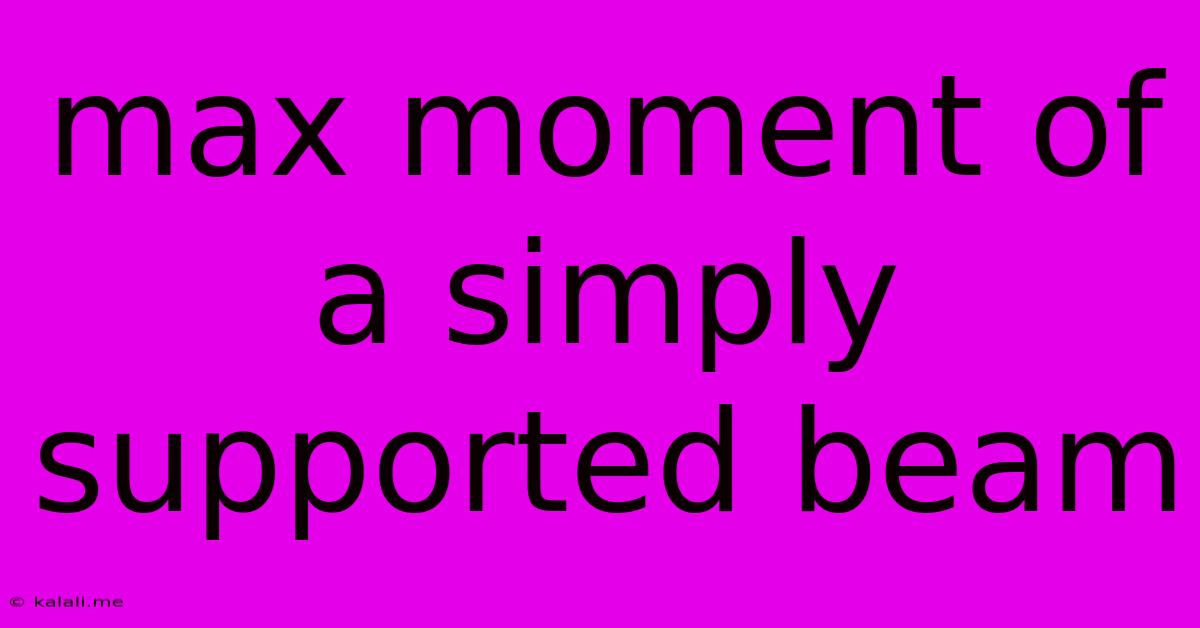Max Moment Of A Simply Supported Beam
Kalali
Jun 13, 2025 · 3 min read

Table of Contents
Understanding the Maximum Moment of a Simply Supported Beam
Determining the maximum bending moment in a simply supported beam is a fundamental concept in structural engineering and mechanics of materials. This article will guide you through understanding this crucial calculation, covering various load scenarios and providing practical examples. Understanding this concept is critical for ensuring the structural integrity and safety of beams used in buildings, bridges, and various other structures.
The maximum bending moment is the point of highest stress within the beam, and knowing its value is essential for selecting appropriate beam sizes and materials to prevent failure. This article explores different loading conditions and how they affect the maximum moment.
What is a Simply Supported Beam?
A simply supported beam is a structural element resting on two supports, typically at its ends, allowing it to rotate freely at these points. Unlike fixed beams, it doesn't have any moment restraint at the supports. This type of support condition is common in many engineering applications.
Calculating Maximum Moment: Different Load Cases
The calculation of the maximum bending moment depends significantly on the type of load applied to the beam. Let's explore some common scenarios:
1. Concentrated Load at the Center:
This is the simplest scenario. For a simply supported beam of length 'L' carrying a single concentrated load 'P' at its midpoint, the maximum bending moment occurs at the center and is calculated as:
- M<sub>max</sub> = PL/4
2. Uniformly Distributed Load (UDL):
A uniformly distributed load is a load spread evenly across the entire length of the beam. For a simply supported beam of length 'L' subjected to a uniformly distributed load 'w' (force per unit length), the maximum bending moment occurs at the midpoint and is:
- M<sub>max</sub> = wL²/8
3. Concentrated Load at an Off-Center Position:
When a concentrated load 'P' is located at a distance 'a' from one support and 'b' from the other (where a + b = L), the maximum bending moment occurs at the point of application of the load and is calculated as:
- M<sub>max</sub> = Pab/L
4. Combination of Loads:
Real-world scenarios often involve multiple loads acting simultaneously. In such cases, the principle of superposition can be applied. This means calculating the moment caused by each load individually and then summing them up algebraically to obtain the total bending moment. The maximum moment will be the largest absolute value obtained in this process. This often involves careful consideration of the sign (positive or negative) of the moments.
Understanding Shear Force and Bending Moment Diagrams
Drawing shear force and bending moment diagrams is an invaluable tool for visualizing the distribution of shear forces and bending moments along the beam's length. These diagrams help identify the location and magnitude of the maximum moment. While creating these diagrams requires an understanding of statics and structural mechanics, they are crucial for accurate analysis and design. Software and online calculators are also frequently used for generating these diagrams, especially for more complex loading scenarios.
Factors Influencing Maximum Moment:
Several factors besides the type and magnitude of load influence the maximum moment in a simply supported beam. These include:
- Beam Length (L): Longer beams generally experience larger maximum moments under the same load.
- Support Conditions: While we've focused on simply supported beams, different support conditions (fixed, cantilever) significantly alter the maximum moment calculation.
- Material Properties: The material's strength and stiffness influence the beam's ability to resist the bending moment. However, the maximum moment itself isn't directly impacted by material properties.
Conclusion
Calculating the maximum bending moment in a simply supported beam is a fundamental task in structural analysis. Understanding the different load cases and utilizing shear force and bending moment diagrams are essential for accurate analysis and design. This knowledge allows engineers to ensure the safety and stability of structures by appropriately selecting beam sizes and materials to withstand the maximum anticipated stress. Remember to always consider all loading scenarios and use appropriate calculation methods to ensure the structural integrity of any beam design.
Latest Posts
Latest Posts
-
Black Soil Is Also Known As
Jun 14, 2025
-
What Is The Lcm Of 27 And 36
Jun 14, 2025
-
Pepsin Is A Protein Digesting Enzyme Produced By The
Jun 14, 2025
-
What Is The Difference Between A Culture And A Civilization
Jun 14, 2025
-
Gpa Needed For University Of Chicago
Jun 14, 2025
Related Post
Thank you for visiting our website which covers about Max Moment Of A Simply Supported Beam . We hope the information provided has been useful to you. Feel free to contact us if you have any questions or need further assistance. See you next time and don't miss to bookmark.